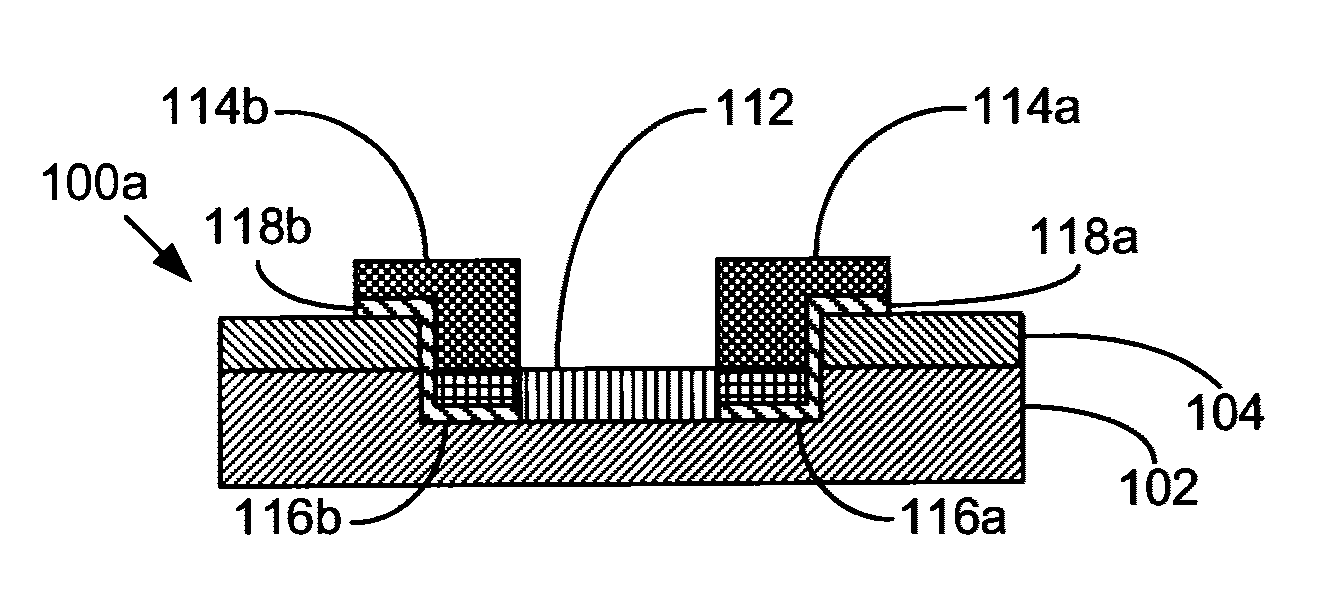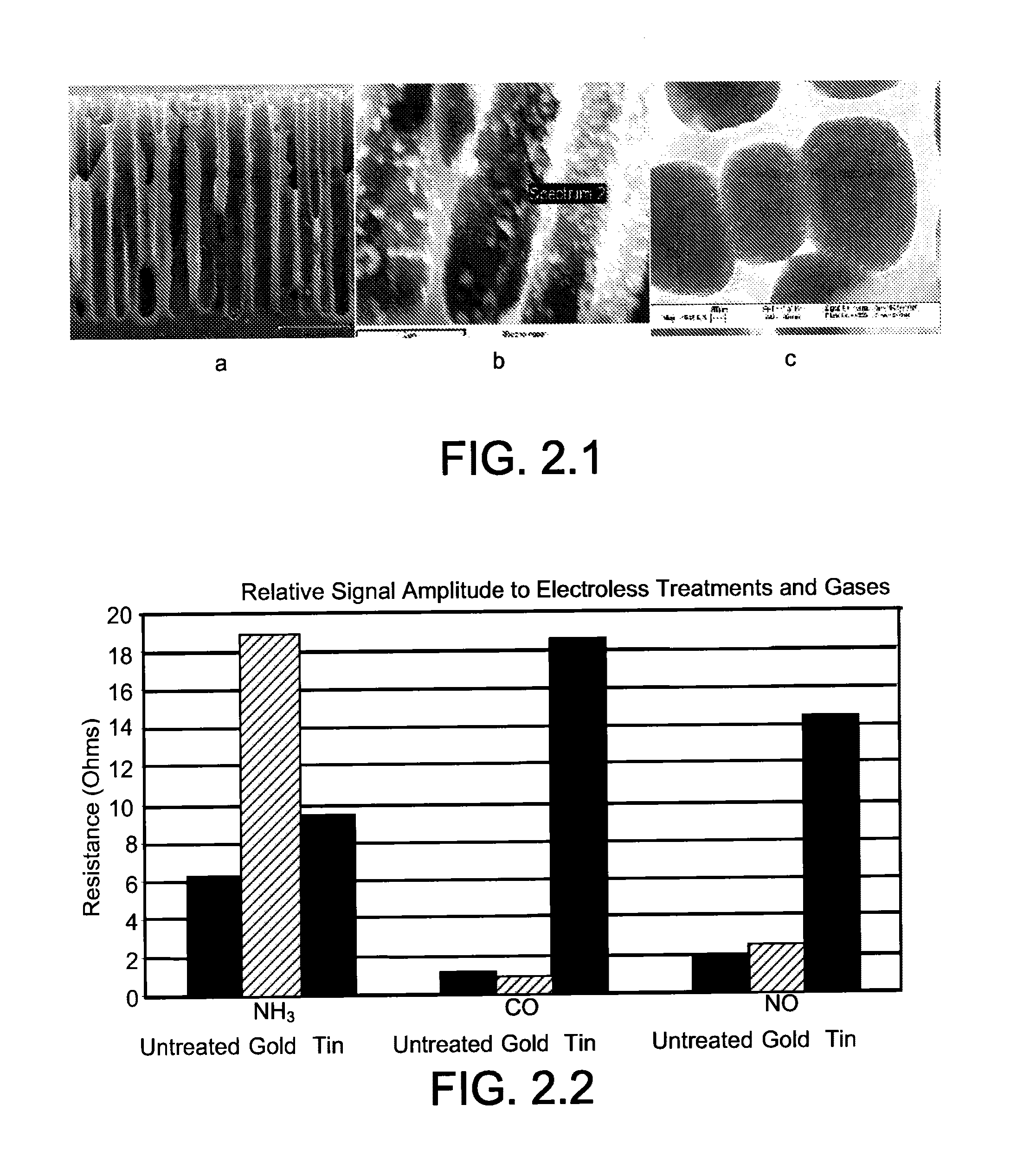Gas Sensors, Methods of Preparation Thereof, Methods of Selecting Gas Sensor Materials, and Methods of Use of Gas Sensors
a technology of gas sensors and sensors, applied in the field of gas sensors, can solve the problems of small size of acceptor atoms and inability to polarize easily, and achieve the effect of significantly reducing the response of porous silicon sensors
- Summary
- Abstract
- Description
- Claims
- Application Information
AI Technical Summary
Benefits of technology
Problems solved by technology
Method used
Image
Examples
example 1
Brief Summary of Example 1
[0135]Within the framework of nanotechnology, we outline a general concept which facilitates significant and predictable changes in sensor sensitivity for a variety of gases. Rapidly responding, reversible, sensitive, and selective porous silicon-based sensors are formed (1) with a highly efficient electrical contact to a nanopore covered microporous channel array and (2) selective nanostructure coating, interaction, and modification of the nanopores. Distinctly variable nanostructures are chosen to provide a range of sensitivities for a given analyte using a concept complementary to that of hard and soft acid-base interactions (HSAB) and commensurate with a basis in dominant physisorption. The concept, based on the reversible interaction of hard acids and bases with soft bases and acids corresponds (1) to the inverse of the HSAB concept and (2) to the selection of sensor and analyte materials which do not result in strong covalent or ionic bonding but rath...
example 2
Brief Introduction to Ex. 2
[0193]Porous silicon surface modification methods have been employed for detecting different gas molecules; including H2O, ethanol, methanol, isopropanol, COx, NOx, NH3, O2, H2, HCl, SO2, H2S and PH3.
Introduction:
[0194]Porous silicon (PS) has drawn considerable attention for sensor applications. Its luminescence properties, large surface area, and compatibility with silicon based technologies have been the driving force for this technology development. Recently biochemical [1-3], microfluidic flow [4], temperature and pressure [5], magnetic [6-7], chemical ion [8] and gas sensors have been reported. Chemical functionalization of the large surface areas, which can be generated in PS, shows the potential for developing a variety of gas sensors. Humidity [9-14], organic solvents [15-23], COx, NOx [27-32], NH3, O2 [27], H2 [24-26], HCl, SO2, H2S, and PH3 have all been detected. In this Example, following a recent publication [*9] in which this work is summariz...
example 3
Brief Introduction
[0265]A concept, complementary to that of hard and soft acid-base interactions (HSAB-dominant chemisorption) and consistent with dominant physisorption to a semiconductor interface, is presented. We create a matrix of sensitivities and interactions with several basic gases. The concept, based on the reversible interaction of hard-acid surfaces with soft bases, hard-base surfaces with soft acids, or vice versa, corresponds 1) to the inverse of the HSAB concept and 2) to the selection of a combination of semiconductor interface and analyte materials, which can be used to direct a physisorbed vs chemisorbed interaction. The technology, implemented on nanopore coated porous silicon micropores, results in the coupling of acid-base chemistry with the depletion or enhancement of majority carriers in an extrinsic semiconductor. Using the inverse-HSAB (IHSAB) concept, significant and predictable changes in interface sensitivity for a variety of gases can be implemented. Nan...
PUM
| Property | Measurement | Unit |
|---|---|---|
| temperatures | aaaaa | aaaaa |
| pressure | aaaaa | aaaaa |
| temperature | aaaaa | aaaaa |
Abstract
Description
Claims
Application Information
 Login to View More
Login to View More - R&D
- Intellectual Property
- Life Sciences
- Materials
- Tech Scout
- Unparalleled Data Quality
- Higher Quality Content
- 60% Fewer Hallucinations
Browse by: Latest US Patents, China's latest patents, Technical Efficacy Thesaurus, Application Domain, Technology Topic, Popular Technical Reports.
© 2025 PatSnap. All rights reserved.Legal|Privacy policy|Modern Slavery Act Transparency Statement|Sitemap|About US| Contact US: help@patsnap.com



